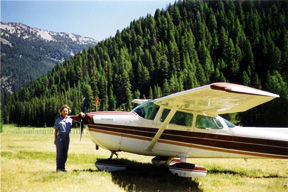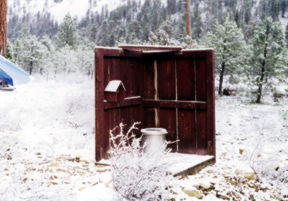|
|
 |
| Interested in an aviation-related book? Find it at... |
|
|
|
|
SW Aviator Magazine
|
3909 Central NE
Albuquerque, NM 87108
Phone: 505.256.7031
Fax: 505.256.3172 |
| publisher@swaviator.com |
|
Establishing Recreational Airports
A Blueprint for Success |
|
Probably more than anywhere, Idaho is recognized in the aviation community for its outstanding collection of recreational airports. These beautiful, mountain-meadow-like airstrips, with amenities such as drinking water, picnic tables, camp-stoves and public showers and toilets, are all free for the flying public. How did these wonderful facilities come to be, and why isn’t every state in the Southwest blessed with such facilities?
 My fond fascination for the many magnificent back-country airport retreats Idaho offers, and my knowledge of the history of their development comes with no small amount of family pride. My father, Chet Moulton, was the State Director of Aeronautics for Idaho from the late forties until his retirement in 1971. These recreational airports were his vision, and he made them a delightful reality. My fond fascination for the many magnificent back-country airport retreats Idaho offers, and my knowledge of the history of their development comes with no small amount of family pride. My father, Chet Moulton, was the State Director of Aeronautics for Idaho from the late forties until his retirement in 1971. These recreational airports were his vision, and he made them a delightful reality.
In the early days of commercial aviation, unpressurized airlines flew the low-frequency airways. Strings of beacons visually ornamented those routes. Federal money was provided to construct emergency landing strips at some maximum interval below the paths taken by paying passengers. These airstrips were marginally adequate for a DC-3, but provided pilots an acceptable alternative to pushing down trees in an emergency or bad weather. Other early back-country airports were carved from the scarce level ground beside rivers and lakes, providing remote access for mail, supplies, mining, forest work, and game management.
By the 1960s, the reliable, high-flying airlines neither needed nor could use those short, rough emergency airstrips. By that time the state of Idaho had approximately 250 airports, many of which were primitive. My father recognized that general aviation pilots were using these strips for hunting, fishing, and camping. Because state and federal agencies were already providing recreational facilities and campgrounds for motorists and boaters, it seemed natural that the state make some effort for the flying public as well. Therefore, the Idaho Aeronautics Department began installing pitcher pump wells for drinking water, privies, picnic tables, camp-stoves, and garbage pits at the more popular back-country airstrips.
During the 1960s, the total operating budget for the Idaho Aeronautics Department was approximately $100,000. With these meager resources, the Department had to be creative in their approach to developing recreational airports. My father decided that coordinated volunteerism was the key to success.
The Aeronautics Department organized volunteer fly-in work parties, with pilots and their families donating their labor. The Department also contacted other government agencies and local businesses who could provide necessary materials and equipment. I remember my father working with Idaho County Commissioners, selling them on the value of air access to their county and region, and begging the temporary use of county equipment and crews for airport work. He obtained donations of diesel fuel for the borrowed heavy equipment from petroleum suppliers who were also pilots. The Department also obtained surplus government cars, trucks, and heavy equipment for free from the Defense Reutilization Management Office. Again they used volunteer work parties to repair, sand and paint the vehicles, and even install slip covers on the worn upholstery. This effort produced courtesy cars at most of Idaho’s airports, even the recreational airports. Idaho state law prohibits courtesy cars at community airports where taxi service is available, but at the time only five communities in Idaho had taxis.
The greatest asset, however, remained the volunteer work force of pilots and their families. During the summer season, specific back-country airports were scheduled for weekend work “parties.” The volunteers flew in early on Saturday morning. The traffic pattern at the chosen airstrip would fill with Bonanzas, Champs, Taylorcrafts, Pipers, and Cessnas, their baggage compartments all stuffed with tools and sleeping bags. These parties were an exciting blend of airshow, pilot bash, and pioneer barn building. Teams were formed to string fence, dig the well, make the garbage pit, install tie downs, and anchor the camp-stoves. We made the runway markers and the segmented circle using available rock. Spray painted white, the markers stood out in crisp contrast to the natural landscape making the strip and the windsock easy eye-catchers. The Aeronautics Department receptionist and secretary set up the camp kitchen, rang the dinner chime, and served meals for the volunteers.
After dinner on Saturday night all the airstrip work party volunteers gathered around the freshly dug fire pit. My father praised everyone’s efforts, and gave out little plaques and trophies. Winners included the pilot that traveled the furthest, the ol dest pilot, the youngest, the hardest worker, and for fun, there was a “Dilbert” award for the biggest goof-up. After a night under the stars enjoying their newly improved recreation site, the volunteers would—perhaps a bit stiffly—climb back into their Bonanzas, Champs, Taylorcrafts, Pipers, and Cessnas for one last, satisfying look at the fruits of their labor from above before heading home. dest pilot, the youngest, the hardest worker, and for fun, there was a “Dilbert” award for the biggest goof-up. After a night under the stars enjoying their newly improved recreation site, the volunteers would—perhaps a bit stiffly—climb back into their Bonanzas, Champs, Taylorcrafts, Pipers, and Cessnas for one last, satisfying look at the fruits of their labor from above before heading home.
The legacy of this fraternal effort is the fine collection of recreational airports in Idaho, and a pilot community that shares a sense of investment and pride. These airports are still maintained largely by volunteer labor and donated resources, coordinated and supported by the State of Idaho.
Recreational airport programs are now active in ten of the 11 western states. The fundamental lessons learned through Idaho’s lasting success remain. State Aviation Departments must commit to supporting recreational airports in their state, then coordinate and nurture a dialog between government agencies, the business sector, and energetic volunteers. Together we can create magical places for pilots and their families to enjoy the natural beauty and myriad recreational opportunities the Southwest has to offer.
Jim Moulton retired from the Air Force after a twenty-year flying career in jets and helicopters. Also rated in gliders and hot-air-balloons, he is frequently a part of the balloon flock over Albuquerque. Currently a contract instructor pilot and an active CFI in the community, he regularly flies his Cessna to Idaho’s recreational airstrips from his Albuquerque, NM home.
|
| Click here to return to the beginning of this article. |
The material in this publication is for advisory information only and should not be relied upon for navigation, maintenance or flight techniques. SW Regional Publishing, Inc. and the staff neither assume any responsibilty for the accuracy of this publication's content nor any liability arising out of it. Fly safe.
|
|
|
|

